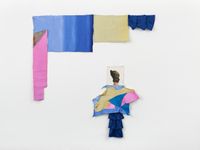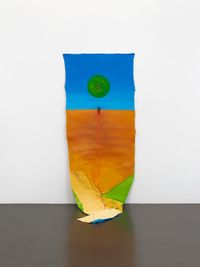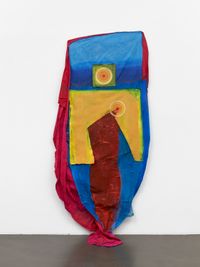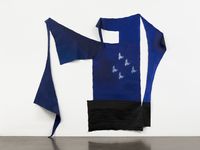



Eternal themes viewed differently.
They are scraps of the real world painted onto fabrics that are gathered together, attached to the wall, spread out on the floor, or shaped into flags and banners. Viewed from this perspective, Lotte Maiwald's works are hybrid structures that defy any classical classification. They thrive on the soft material radiance of the flowing fabrics, which are often tattered at the edges and thus evoke a certain vulnerability. This makes them similar to the fabric sculptures of the artist Rosemary Mayer, for example, but only similar, because Maiwald's works are not limited to their material effect in the way Mayer's are. Maiwald's works combine the effect of the material—fabric—with the effect of the images painted on them. They enter into a unity with the fabric, although this is not free from contradiction; on the one hand is the often ephemeral, impermanent, frayed nature of the fabrics, on the other is the often harsh reality of the painted images. This effect imbued with contradiction and tension characterises Maiwald's oeuvre and is heightened further by the painted motifs, sometimes creating the impression that the layered fabrics are about to collapse under their weight.
But what exactly are the images that mistreat these flowing fabrics? They are representative of an entire cosmos from which they seem to have been mercilessly snatched. Take the hand motif, for example. It appears again and again. A fist clad in a leather glove hovers in front of a sky-blue background, pointing into the depths at one point, then underneath at another (Handschuhgeste, Glove Gesture, 2022); a different hand appears behind a vivid green lawn as if pleading for help, while two boxing gloves rest on a glass plate balanced on two elegantly raised fingers (Wer verbirgt sich hinter der grünen Fläche?, Who Is Hiding behind the Green Surface?, 2022).
A hand hovering in empty space—the cosmos—above the events taking place below was an integral element of early Christian imagery. It was the guiding hand of the Pantocrator, the ruler of the world. In Maiwald's images it is unequivocally a human hand. But what is it guiding? It is clenched into a fist, a sign of protest that can turn into violence—which is what the boxing gloves represent. But why is it wearing a glove? And what does the pleading hand mean? Rather than a call for people to intervene in global events, these images of a lone human hand against an endless background seem rather powerless. But if we consider the work Hand gegen Handfeuerwaffe (Hand vs Handgun) from 2022, which shows a raised fist in a leather glove on a base made of colourful scraps of fabric, framed by equally colourful hanging flags, this image of a fist attempting to confront a firearm does not miss the mark; its absurdity is what makes it provocative.
The work Hier Paintball, da tödliche Realität (Here Paintball, There Deadly Reality) from 2021 is also absurd, even a little sinister. This landscape painted on a flag with ocher-coloured Earth and a bright blue sky is supposed to be deadly reality? It's not—until you discover a gun on the horizon line, pointed directly at the viewer. And that's not all: a green target with a bullet hole in the middle floats above the gun. Who is shooting at whom here? Who is the victim here, and who is the attacker? The amiably sinister feel encountered by the viewer here is precisely calculated; rather than bringing Maiwald closer to surrealism, it aligns her with the artist Rosemarie Trockel, who always manages to add a startlingly sinister touch to her works in a similarly elegant way with feminine subtlety.
Maiwald's images featuring doves are equally subtle. These also belong to her idiosyncratic cosmos, the artist daring to bring this well-worn symbol of peace back into the picture. Against a bright red background, a hand holds a white dove with outstretched wings. The dove seems to want to fly, but it does not fly away. Taube im Griff (Dove in Hand) is the title of this work from 2022, and in another painting from 2020 titled Taubenformation (Dove Formation), five white doves are flying in front of a dark blue background formed of assembled scraps of blue and black fabric. Because of the tattered pieces of fabric and their dark colours, the resulting formation seems rather threatening, again undermining the message of peace traditionallyattributed to the white dove and thus causing the overall effect of the work to slip into the absurd. And it is precisely this moment of toppling into absurdity that saves the otherwise inherently banal work by lending it a contradictory ambiguity. This ability to skillfully stage such a moment is evidence of the provocative humour that, despite the sometimes uncomfortable messages, can conjure up a smile on the faces of the viewers, thus establishing a critical distance to what is depicted and, ultimately, to itself.
Maiwald's works are about peace, violence and hope, but also about threats to Earth, whether through environmental pollution, as indicated by the depictions of the planet surrounded by space debris, or, as in recent times, through war in Europe, which is referenced in the image ... am Strand entlang rennen ... (...running along the beach ...), which was created in 2023 and portrays a girl running along the beach with a helicopter buzzing above her head like a harmless insect in the crystal clear sky. In other words, they deal with eternal themes whose depiction can easily slip into a simplistic boldness. But this is precisely what sets this artist apart: her images never fall into this trap, because the contradictory and ambiguous elements revealed at the moment that the works topple into absurdity give them a provocative quality. A quality that repeatedly eludes any attempt at grasping it or tracing what is depicted back to familiar territory. Maiwald's oeuvre thus becomes a catalyst for a slightly different yet ultimately identical way of viewing these eternal themes.
Noemi Smolik
Poststrasse 2+3
Düsseldorf, 40213
Germany
www.sieshoeke.com
+49 211 301 4360
Monday–Friday: 10am–6.30pm
Saturday: 12pm–2.30pm